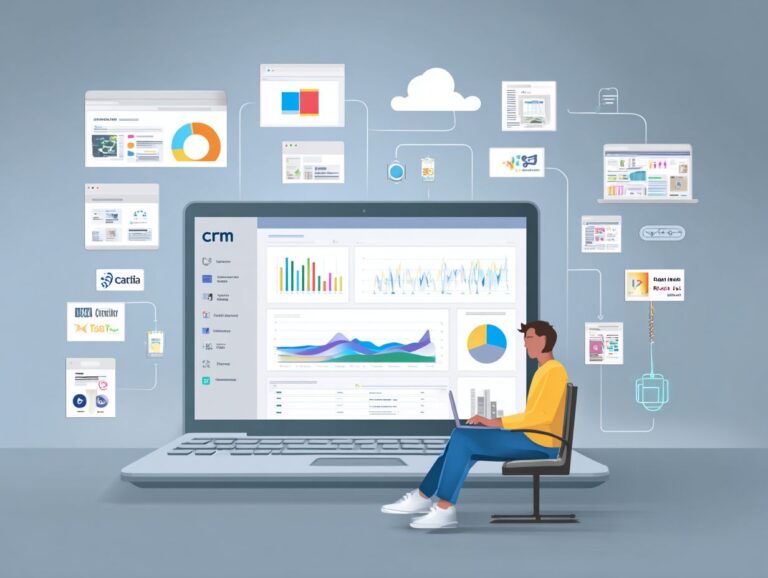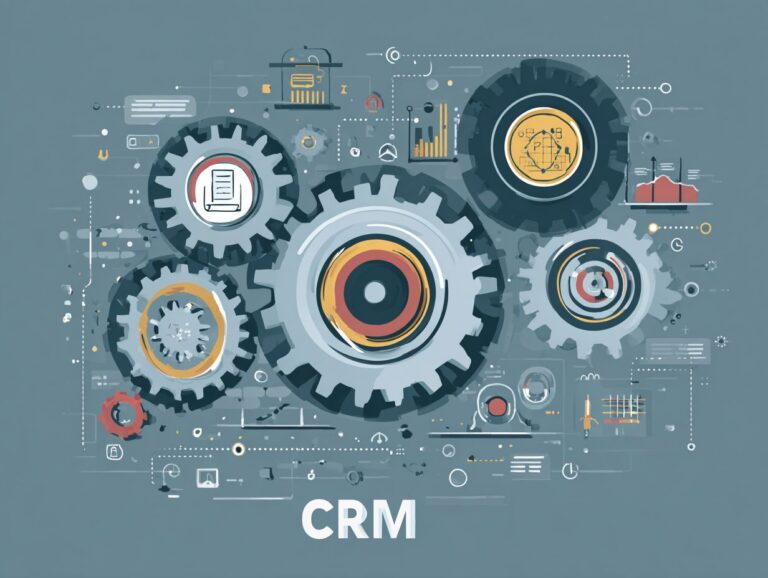How to Assess Your CRM Implementation: Guide for Businesses
Is your customer relationship management (CRM) implementation driving the results you expected? A good CRM improves how businesses connect with customers and increases sales efficiency. This guide will help you evaluate your CRM tools, using advice from experts like Meta Group. By reviewing your CRM strategy, you’ll find what works well and what needs fixing, helping your business succeed in a competitive market. Learn how to make the most of your CRM.
Key Takeaways:
- Set clear CRM goals and identify key performance indicators (KPIs) to measure success.
- Increase user engagement by collecting feedback and evaluating how well the training works.
- Check how good the data is and how it is handled to keep it correct and whole.
- Evaluate CRM features and functionality, including integration with other systems, to maximize its potential.
- Analyze customer engagement metrics, such as satisfaction scores and retention rates, to gauge CRM effectiveness.
- Regular assessment of your CRM implementation will help identify areas for improvement and drive business growth.
- Defining Your CRM Goals
- Evaluating User Adoption
- Measuring Data Quality
- Analyzing CRM Features and Functionality
- Reviewing Customer Engagement Metrics
- Frequently Asked Questions
- 1. How can I assess my CRM implementation as a business?
- 2. What are some key indicators of a successful CRM implementation?
- 3. What steps can I take to improve my CRM implementation?
- 4. What are some common challenges businesses face when implementing a CRM system?
- 5. What steps can I take to make sure my CRM setup fits my business objectives?
- 6. Why is it important to continuously assess my CRM implementation?
Importance of CRM in Business

Using a reliable CRM system can raise sales productivity by 30%, resulting in significant revenue growth. CRM systems make it easier to know customers by combining all information in one simple location.
For example, a retail client used Salesforce to follow customer interactions on different platforms, resulting in custom marketing campaigns. See also: Customer Experience And Technology: A Revolutionary Approach.
Teams can quickly share notes and updates, helping everyone stay informed and collaborate more effectively. Data accuracy improves with automatic entries and deduplication features, reducing human mistakes. These combined benefits help sales teams to concentrate on developing relationships, which leads to increased customer loyalty and more sales.
Defining Your CRM Goals
Clear CRM goals help organizations improve their focus on customers, leading to better business results. To fully leverage these goals, it’s essential to understand the key performance indicators of customer experience, which provide measurable insights into how effectively you’re engaging with your clientele.
Identifying Key Performance Indicators (KPIs)
Establishing KPIs, such as customer satisfaction scores and retention rates, helps businesses measure CRM effectiveness. Five critical KPIs for assessing CRM performance are:
- customer acquisition cost
- customer lifetime value
- sales conversion rates
- customer satisfaction
- retention rate
For instance, using HubSpot, you can track your customer acquisition cost by analyzing the total marketing expenses divided by new customers gained. Similarly, customer lifetime value can be calculated by estimating the average revenue per customer multiplied by purchase frequency, helping you gauge long-term profitability.
Creating dashboards for these metrics in HubSpot enables live tracking, helping you adjust strategies based on how the data is performing.
Evaluating User Adoption
How well your team uses the CRM system directly affects its success. Checking this helps find any problems. For an extensive analysis of how effective customer experience strategies can enhance CRM utilization, consider our comprehensive study on key performance indicators.
1. Gathering User Feedback
Regular user feedback can show where your CRM software needs improvement, helping the team work together better.
To gather feedback effectively, consider using a variety of approaches.
- Begin by sending out surveys using platforms like SurveyMonkey to connect with many people; focus on detailed questions about how easy the product is to use and its features.
- Speak with individuals one-on-one to gather detailed information about their experiences, allowing for direct communication.
- Organize team workshops to facilitate open discussions, allowing team members to share their experiences collaboratively.
It’s important to carefully review this feedback and make plans to fix any problems, promoting ongoing growth.
2. Assessing Training Effectiveness

Evaluating training programs ensures that all team members fully understand how to use your CRM.
- To assess training effectiveness, begin with pre- and post-training assessments to measure knowledge gained.
- Monitor usage metrics, such as login frequency and feature engagement, using tools like Salesforce Analytics or HubSpot Reports.
- Follow up with sessions 1-3 months after training to gather feedback and encourage ongoing learning.
This organized method will identify where things can get better and keep the team interested in the CRM, leading to improved results.
Measuring Data Quality
Accurate data is crucial for CRM systems because it helps in making smart decisions and knowing customer details. To optimize the effectiveness of CRM, understanding the role of customer feedback is key. Learn more about strategic customer feedback and how it enhances data accuracy and decision-making.
1. Data Accuracy and Completeness
Maintaining data accuracy can improve sales team efficiency by up to 20%, reducing time spent on manual corrections.
To keep data correct, run regular checks with tools like Data Ladder or Talend, which handle data checking and cleaning automatically. For example, a leading retail company used Talend to identify discrepancies in their customer database, resulting in a 30% increase in lead conversion rates.
Instituting strict data entry protocols can help prevent inaccuracies. Teaching your team effective approaches to handling data helps these goals, building a mindset of responsibility and carefulness that contributes to better data quality overall.
2. Data Management Practices
Using effective data management can help businesses understand their customers better and run operations smoothly.
To achieve this, consider these five best practices:
- Keeping data clean ensures information stays correct by getting rid of outdated or incorrect data. Standardizing data entry makes sure all records are consistent.
- Use automation tools like Zapier to easily move data between applications, cutting down on mistakes from manual entry.
- Using dependable backup techniques means you can recover your data if there is a problem.
- Establishing a data governance strategy provides clear protocols for data usage and security, helping your team manage information effectively and comply with regulations.
Analyzing CRM Features and Functionality
A detailed look at CRM features can show overlooked tools that greatly improve how effectively users work. For instance, implementing strategies from our Ultimate Guide to Customer Feedback Strategy can further enhance user effectiveness.
1. Feature Utilization Assessment

Using CRM tools well can increase sales efficiency by up to 25%. To effectively assess CRM feature utilization, follow these steps:
- First, analyze user activity reports to determine how often each feature is used.
- Next, identify the most popular tools within your CRM by evaluating engagement metrics.
- After gathering this data, ask users for their opinions to find out which features they like or find difficult to use.
- Using your findings, set up specific training sessions to help your team get better with tools they don’t use often, so they can make full use of the CRM and increase sales success.
2. Integration with Other Systems
Linking CRM with other business systems can simplify processes and improve data sharing within the company. Integrating your CRM system, such as Salesforce, with marketing automation tools like HubSpot can significantly improve lead tracking and customer engagement.
For example, using Zapier, you can set up processes that automatically move new leads from web forms directly into your CRM, ensuring you capture all potential customers.
Integrating email marketing platforms like Mailchimp allows for targeted campaigns based on customer segmentation from your CRM data. Working together saves time and keeps data correct, leading to a better grasp of the business.
Reviewing Customer Engagement Metrics
Studying how customers interact with your company gives important information about how well your CRM plan and customer communication are working.
1. Customer Satisfaction Scores
Monitoring customer satisfaction scores can reveal areas for improvement, driving increased loyalty and retention. To track customer satisfaction effectively, implement Net Promoter Score (NPS) surveys using tools like SurveyMonkey or Typeform.
Start by designing a simple survey asking customers to rate their likelihood of recommending your service on a scale from 0 to 10. For instance, after a purchase, send an email with the survey link.
Analyze the results to identify trends; for instance, a company that adopted targeted follow-ups for scores below 6 saw a 20% increase in customer satisfaction within six months. This proactive approach can turn passive customers into loyal advocates.
2. Retention and Churn Rates
Tracking customer retention and loss rates is important for knowing how strong your customer relationships are and spotting possible problems. To calculate these metrics, track the number of customers you retain over a specific period compared to the number lost.
Use the formula:
- Retention Rate = (Customers at End – New Customers) / Customers at Start.
- Churn Rate = Customers Lost / Customers at Start.
To make things better, send specific emails to reconnect with customers and use surveys to collect their opinions. Using CRM tools like HubSpot can make this process automatic, giving useful information and alerts for active interaction plans.
Frequently Asked Questions

1. How can I assess my CRM implementation as a business?
To evaluate your CRM setup, begin by thoroughly examining your existing system and processes. This should include evaluating the effectiveness of your CRM software, data management, and overall usage by employees and customers.
2. What are some key indicators of a successful CRM implementation?
Some key indicators of a successful CRM implementation include increased customer satisfaction, improved customer retention rates, and a higher return on investment. Additional metrics to consider are the accuracy of data, user adoption rates, and overall business growth.
3. What steps can I take to improve my CRM implementation?
To improve your CRM implementation, you can first identify areas of weakness and develop a plan to address them. This could involve additional training for employees, implementing new processes, or upgrading your CRM software. It is also important to regularly monitor and adjust your implementation as needed for optimal results.
4. What are some common challenges businesses face when implementing a CRM system?
Some common challenges businesses face when implementing a CRM system include resistance to change from employees, difficulty in integrating the system with existing processes, and issues with data management and accuracy. To have a successful CRM implementation, we need to predict and tackle these challenges.
5. What steps can I take to make sure my CRM setup fits my business objectives?
To make sure your CRM setup matches what your business wants to achieve, clearly set your goals and objectives right from the beginning. This will help direct the setup process and make sure the system fits your exact business needs. Regularly reviewing and adjusting goals can also help keep the implementation on track.
6. Why is it important to continuously assess my CRM implementation?
Regularly checking your CRM setup is important to make sure it fits your business needs and produces positive outcomes. This also helps find any problems or areas that need improvement, and gives the chance to make necessary changes to improve the system and its effect on your business.





